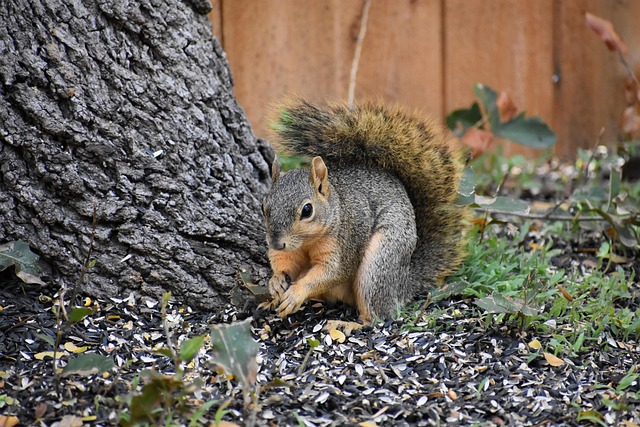Squirrels exhibit distinct seasonal patterns that drive their behavior, from spring's territory establishment and breeding to summer's focused foraging and autumn's winter preparation. Understanding these cycles is key for residential squirrel treatment, especially in spring when they emerge from hibernation and seek food and nesting sites. Proactive measures like securing outdoor food sources and maintaining structures can help deter squirrels during winter, promoting peaceful coexistence with these creatures.
Squirrels are year-round inhabitants of our residential areas, and understanding their seasonal patterns can help with effective management. This guide explores the behavior of squirrels throughout the seasons, offering insights into their activities and preparations for each phase. From spring’s awakening from hibernation to summer’s intense foraging, autumn’s nesting habits, and winter’s dormancy, we provide practical tips for residential squirrel treatment, ensuring a harmonious coexistence with these furry friends.
Understanding Squirrel Seasonal Behavior: A Year-Round Guide
Squirrels, being creatures of habit, exhibit distinct seasonal patterns that influence their behavior and activities. Understanding these cycles is crucial for those seeking residential squirrel treatment and management. Throughout the year, squirrels adapt to changing environments, which in turn affects their feeding, nesting, and overall activity levels.
In spring, squirrels become more active as they emerge from hibernation, ready to establish territories and find mates. This is a prime time for breeding and raising young. During summer, their energy is focused on foraging and storing food for the impending winter. You’ll often see them busily gathering acorns and nuts, hiding them in various locations for later consumption. As autumn arrives, squirrels become increasingly occupied with preparing for the cold season by collecting materials for insulation and caching food reserves. Winter brings a decrease in activity as squirrels conserve energy, but they remain active during favorable weather conditions, especially when food is abundant.
Spring: Awakening from Hibernation and Reproduction
As winter’s chill subsides, spring brings a stirring awakening for squirrels. After emerging from their hibernation dens, these energetic creatures embark on a mission to secure food sources and prepare for the upcoming breeding season. This period is crucial for residential squirrel treatment as the animals seek out nesting sites within homes and buildings, attracted by the warmth and potential food storage spaces.
Spring also marks a time of intense reproduction activity. Squirrel couples establish territories, build nests, and ensure their offspring are well-fed and protected. Residents living in areas prone to squirrel invasions should be vigilant during this season, as squirrels’ natural behavior can lead to unwanted interactions with humans, particularly when they invade homes in search of food or suitable nesting sites.
Summer: Foraging and Food Storage for the Coming Cold
During summer, squirrels are at their most active as they focus on gathering food for the impending cold months ahead. This is a critical period for residential squirrel treatment, as it’s when you’ll likely notice them most in your yard and gardens. Squirrels are efficient foragers, collecting nuts, seeds, fruits, and insects to stockpile for later use. They have evolved excellent memory and navigation skills, allowing them to remember food sources and create extensive underground networks of burrows and storage chambers.
As the summer draws to a close, their behavior shifts towards preparing for winter. Squirrels become busier than ever, storing food in various locations, including under leaves, inside hollow trees, or even in spaces between rocks. This food storage is a strategic move to ensure they have enough sustenance during the colder months when food sources are scarce. Understanding this seasonal pattern can help homeowners implement effective residential squirrel treatment methods, such as securing outdoor food sources and maintaining structures to prevent unwanted winter guests.
Autumn: Preparing for Winter and Nesting Habits
As autumn arrives, squirrels become increasingly busy preparing for the colder months ahead. This is a critical time for their survival, as they need to gather sufficient food and construct secure nests to endure winter’s harsh conditions. In residential areas, observing these behaviors can provide valuable insights into the best times to consider residential squirrel treatment.
During this season, squirrels focus on collecting nuts, seeds, and fruits, storing them in hidden caches for later consumption. They also invest time in building and reinforcing their nests, often using leaves, twigs, and bark to create comfortable, insulated habitats. These nesting habits can lead to increased squirrel activity around homes, as they scurry about gathering materials and establishing safe spaces. Understanding this seasonal behavior is crucial for homeowners looking to coexist peacefully with these furry visitors and potentially avoid unwanted interactions that may require residential squirrel treatment services.
Squirrels’ seasonal patterns provide valuable insights into their behavior, from spring’s awakening and reproduction to summer’s intense foraging and autumn’s meticulous preparation for winter. Understanding these cycles is essential for anyone seeking effective residential squirrel treatment. By following preparation tips tailored to each season, homeowners can ensure a harmonious coexistence with these bushy-tailed visitors while maintaining a pest-free environment.
